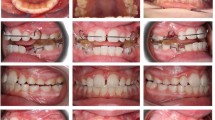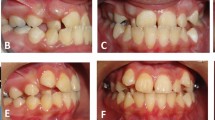Abstract
Data sources
The Cochrane Oral Health Group's Trials Register, the Cochrane Central Register of Controlled Trials (CENTRAL), Medline and Embase databases were searched.
Study selection
Randomised controlled trials of orthodontic treatments to correct prominent lower front teeth.
Data extraction and synthesis
Study screening and data extraction and risk of bias assessment were carried out independently by two reviewers. Meta-analysis was only undertaken when studies of similar comparisons reported comparable outcome measures.
Results
Seven RCTs with a total of 339 participants were included in this review. Three studies were at high risk of bias, three unclear and one at low risk. Four studies reported on the use of a facemask, two on the chin cup, one on the tandem traction bow appliance, and one on mandibular headgear. One study reported on both the chin cup and mandibular headgear appliances.
One study (n = 73, low quality evidence), comparing a facemask to no treatment, reported a mean difference (MD) in overjet of 4.10 mm (95% confidence interval (CI) 3.04 to 5.16; P value < 0.0001) favouring the facemask treatment. Two studies comparing facemasks to untreated control did not report the outcome of overjet. Three studies (n = 155, low quality evidence) reported ANB (an angular measurement relating the positions of the top and bottom jaws) differences immediately after treatment with a facemask when compared to an untreated control. The pooled data showed a statistically significant MD in ANB in favour of the facemask of 3.93° (95% CI 3.46 to 4.39; P value < 0.0001). There was significant heterogeneity between these studies (I2 = 82%). This is likely to have been caused by the different populations studied and the different ages at the time of treatment.
One study (n = 73, low quality evidence) reported outcomes of the use of the facemask compared to an untreated control at three years follow-up. This study showed that improvements in overjet and ANB were still present three years post-treatment. In this study, adverse effects were reported, but due to the low prevalence of temporomandibular (TMJ) signs and symptoms no analysis was undertaken.
Two studies (n = 90, low quality evidence) compared the chin cup with an untreated control. Both studies found a statistically significant improvement in ANB, and one study also found an improvement in the Wits appraisal. Data from these two studies were not suitable for pooling.
A single study of the tandem traction bow appliance compared to untreated control (n = 30, very low quality evidence) showed a statistically significant difference in both overjet and ANB favouring the intervention group.
Conclusions
There is some evidence that the use of a facemask to correct prominent lower front teeth in children is effective when compared to no treatment on a short-term basis. However, in view of the general poor quality of the included studies, these results should be viewed with caution. Further randomised controlled trials with long follow-up are required.
Similar content being viewed by others
Commentary
Class III malocclusions can be treated in a variety of ways at different stages of development. It has long been debated whether early orthodontic intervention may reduce the need for surgical correction after skeletal maturation. Surgical correction involves significant facial surgery with substantial morbidity, along with a protracted period of orthodontic treatment. Conversely early orthodontic intervention involves a protracted period of orthodontics at a relatively young age, beginning in pre-adolescence with appliances that are unsightly and can be difficult to tolerate. At present it is unknown which, if any, early orthodontic intervention gives the best long-term patient outcome.
The object of this Cochrane systematic review was to examine the effects of early orthodontic treatment of class III malocclusion in children and included studies looking at the use of facemask, chin cup, mandibular headgear and tandem traction bow appliances compared to no treatment or delayed treatment.
Cochrane reviews are well known for their methodological rigour and minimisation of bias and this one certainly doesn't disappoint. It describes in comprehensive detail the methodology used and design of the review. The Cochrane Collaboration statistical guidelines were adhered to for data analysis with heterogeneity and bias also thoroughly assessed, although insufficient studies were identified to investigate reporting bias. Considerable effort was undertaken to contact the authors of the studies to confirm details missing from the methodology of the trials.
The lack of long-term data and small sample sizes made it difficult for the authors to draw conclusions other than the need for more high quality long-term research into this area. The trial assessed as having the lowest overall risk of bias investigated in this systematic review1 is still ongoing and we keenly await publication of the six-year results. It is hoped that the review will be updated, as it will be interesting to see how the authors view long-term data from this.
The authors have made clear indications for outcomes and appropriate methodologies for any prospective studies and concluded that further long-term follow-up randomised controlled trials were required. This is probably its greatest strength. If these are adhered to and meta-analysis shows that cumulative treatment effects from early intervention can reduce the need for invasive surgery then orthodontists may be happier to persuade their younger patients to accept these early treatments.
References
Anne Mandall N, Cousley R, DiBiase A, et al. Is early class III protraction facemask treatment effective? A multicentre, randomized, controlled trial: 3-year follow up. J Orthod 2012; 39: 176–185.
Author information
Authors and Affiliations
Additional information
Address for correspondence: Luisa Fernandez Mauleffinch, Review Group Co-ordinator, Cochrane Oral Health Group, MANDEC, School of Dentistry, University of Manchester, Higher Cambridge Street, Manchester, M15 6FH, UK. E-mail: luisa.fernandez@manchester.ac.uk
Watkinson S, Harrison JE, Furness S, Worthington HV. Orthodontic treatment for prominent lower front teeth (Class III malocclusion) in children. Cochrane Database Syst Rev 2013; 9: Art. No. CD003451. DOI: 10.1002/14651858.CD003451.pub2.
This paper is based on a Cochrane Review published in the Cochrane Library 2013, issue 9 (see www.thecochranelibrary.com for information). Cochrane Reviews are regularly updated as new evidence emerges and in response to feedback, and the Cochrane Library should be consulted for the most recent version of the review.
Rights and permissions
About this article
Cite this article
Shadrick, V., Walker, M. Facemask therapy between ages six to ten years may lead to short term improvements for Class III malocclusions. Evid Based Dent 14, 112–113 (2013). https://doi.org/10.1038/sj.ebd.6400969
Published:
Issue Date:
DOI: https://doi.org/10.1038/sj.ebd.6400969
This article is cited by
-
Dental compensation for skeletal Class III malocclusion by isolated extraction of mandibular teeth
Journal of Orofacial Orthopedics / Fortschritte der Kieferorthopädie (2015)



